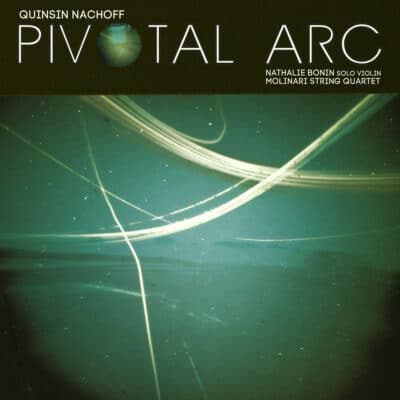Quinsin Nachoff Pivotal Arc
Quinsin Nachoff
Pivotal Arc
Whirlwind Recordings
Say the words “classical music” and it scares off plenty of would-be listeners, even the most fervent jazz listeners. Yet, we have so many examples of classical music in jazz from Miles to Mingus to Corea to Wayne Shorter and to the more contemporary Ambrose Akinmusire, to name a few. The blending of the two creates some imaginative possibilities. Saxophonist and composer Quinsin Nachoff is another artist whose career has delivered a boundary-crossing body of work that’s full of creative passion, encompassing a very broad swath. Pivotal Arc may be his most ambitious project yet: bringing together virtuoso violin soloist Nathalie Bonin with a jazz-inflected unit comprising two established giants of the NY scene, bassist Mark Helias and drummer Satoshi Takeishi, and the stunning young vibraphone player Michael Davidson, and adding a wind and string ensemble conducted by JC Sanford for a concerto that uniquely mixes written and improvised sections. A contemporary string quartet performed by the renowned Molinari String Quartet and the extended title piece round out the album. The result is three diverse long-form works that flow naturally together, demonstrating Nachoff’s facility with the free-flowing language of jazz improvisation, the depth and rigor of classical composition and the direct melodicism of folk forms.
The three-part violin concerto is built around Nachoff’s long-standing creative partnership with Nathalie Bonin and showcases her extraordinary range and versatility. To be sure, Bonin’s bent is more classical unlike Regina Carter who is more blues and jazz centric. The first movement is an imaginary deconstructed and reconstructed Tango that sets the tone, intensity and sound palette for the entire work. After the improvised violin solo, the orchestra returns in full force with nearly a concerto for orchestra section that gradually winds down to a dream-like cadenza, setting up the second movement, a haunting ballad that sweeps through several tonal landscapes “Where Berg meets Ellington!” A gorgeous improvised violin solo leads into both a written and improvised cadenza that connects to the final movement. It is Balkan-infused and showcases the violinist’s virtuosic range and rhythmic strength.
The String Quartet represents some of Nachoff’s most intricate writing to date, allowing him to explore his deep attachment to the tradition and his engagement with contemporary iterations. Each of the four movements is a miniature concerto for each member of the quartet. The first movement features Violin II, the probing second movement showcases the Viola, the vacillating third movement is for the Cello and the intense final movement is for Violin I. “It felt like it was improvised, it had this really alive, vibrant feeling to it that is a testament to the Molinari’s exceptional work as an ensemble,” said Nachoff. Even with the emphasis on the string instruments, there’s ample room for Nachoff’s sax and brilliant work from the rhythm section of Helias and Takeishi. The blending of Nachoff’s horn with the strings is a central aspect of the album’s unique sound. Listen to the entire ensemble bring Movement 1 to a stunning climax, for example.
The title track, ‘Pivotal Arc’ is Nachoff’s extended reflection on the critical position we currently find ourselves in regarding climate change. It features opening and closing solos from bassist Mark Helias, inspired contributions throughout from Michael Davidson, a call and response solo section between the orchestra and drummer Takeishi and an improvisation section moving through a variety of moods for Nachoff’s tenor saxophone.
With a sonic palette that ranges across the spectrum from Strayhorn and Mancini to Bartok and Berg, this is a stunningly original set of pieces that will cement Nachoff’s reputation as a major cross-genre musical force. Within the structured pieces, he still finds plenty of opportunities to play in an improvisational style. If you’ve gotten this far, you may want to do some research on both Nachoff and Bonin. Each boast impressive resumes of cross-genre projects. In the meantime, this music is an intriguing blend of mysterious, emotional, cinematic, and unpredictable moods and textures. It can take your mind to faraway places.
- Jim Hynes
Discover more from Making A Scene!
Subscribe to get the latest posts sent to your email.














































